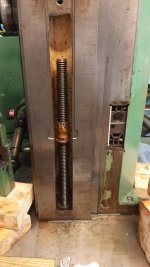Hi
All axis mowed very easy on my F3 until one morning.
The vertical was heavy to crank , and it went worse quick .
I am dismantling the vertical slide to find the problem
I following the steps in the manual
But I cant get the slide up to the top so the feed screw cames out of the nut
Everything is loose what i can see and feel.
I even took the gib away and tried .
Can the problem be between the nut and screw ? I need to get it apart anyway
but seems impossible when I cant crank the slide of the leadscrew
Anyone else had this problem and now what i should do ?
Thanks Johan
All axis mowed very easy on my F3 until one morning.
The vertical was heavy to crank , and it went worse quick .
I am dismantling the vertical slide to find the problem
I following the steps in the manual
But I cant get the slide up to the top so the feed screw cames out of the nut
Everything is loose what i can see and feel.
I even took the gib away and tried .
Can the problem be between the nut and screw ? I need to get it apart anyway
but seems impossible when I cant crank the slide of the leadscrew
Anyone else had this problem and now what i should do ?
Thanks Johan

Attachments
Last edited:







